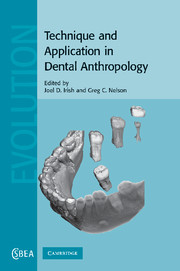Book contents
- Frontmatter
- Contents
- Contributors
- Acknowledgments
- Section I Context
- Section II Applications in assessing population health
- 4 Using perikymata to estimate the duration of growth disruptions in fossil hominin teeth: issues of methodology and interpretation
- 5 Micro spatial distributions of lead and zinc in human deciduous tooth enamel
- 6 The current state of dental decay
- 7 Dental caries prevalence by sex in prehistory: magnitude and meaning
- 8 Dental pathology prevalence and pervasiveness at Tepe Hissar: statistical utility for investigating inter-relationships between wealth, gender, and status
- Section III Applied life and population history
- Section IV Forefront of technique
- Index
- References
4 - Using perikymata to estimate the duration of growth disruptions in fossil hominin teeth: issues of methodology and interpretation
Published online by Cambridge University Press: 12 September 2009
- Frontmatter
- Contents
- Contributors
- Acknowledgments
- Section I Context
- Section II Applications in assessing population health
- 4 Using perikymata to estimate the duration of growth disruptions in fossil hominin teeth: issues of methodology and interpretation
- 5 Micro spatial distributions of lead and zinc in human deciduous tooth enamel
- 6 The current state of dental decay
- 7 Dental caries prevalence by sex in prehistory: magnitude and meaning
- 8 Dental pathology prevalence and pervasiveness at Tepe Hissar: statistical utility for investigating inter-relationships between wealth, gender, and status
- Section III Applied life and population history
- Section IV Forefront of technique
- Index
- References
Summary
Introduction
Enamel hypoplasias are developmental defects of tooth enamel taking the form of pits, horizontal lines, grooves, or, occasionally, altogether missing enamel (FDI DDE Index, 1982, 1992). These defects result from disturbances to ameloblasts (enamel-producing cells) during the secretory phase of enamel formation (Goodman and Rose, 1990; Ten Cate, 1994). When systemic physiological stress, such as malnutrition or illness, disturbs enamel formation, all crowns forming during the period of stress are likely to develop enamel hypoplasias (Hillson, 1996). Once formed, these defects become permanent features of the crown, unless worn away by abrasion or attrition. For these reasons, and because teeth are the most abundant of skeletal remains (Hillson, 1996), enamel hypoplasias have become one of the most important sources of information about systemic physiological stress in fossil hominins (Bailey and Hublin, 2006; Bombin, 1990; Brennan, 1991; Brunet et al., 2002; Guatelli-Steinberg 2003, 2004; Guatelli-Steinberg et al., 2004; Hutchinson et al., 1997; Moggi-Cecchi, 2000; Molnar and Molnar, 1985; Ogilvie et al., 1989; Tobias, 1991; White, 1978).
Linear enamel hypoplasia (LEH) is the most common type of hypoplastic defect, taking the form of “furrows” on the enamel surface (Hillson and Bond, 1997). Of the different types of hypoplastic defects, LEH has the greatest potential to reveal information about the duration of enamel growth disturbances. This potential resides in several crucial facts about enamel formation and in the nature of LEH defects themselves.
- Type
- Chapter
- Information
- Technique and Application in Dental Anthropology , pp. 71 - 86Publisher: Cambridge University PressPrint publication year: 2008
References
- 11
- Cited by



